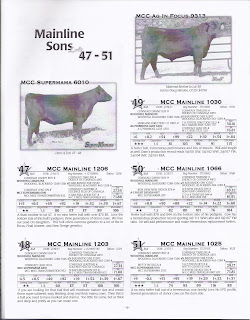When you go to a bull auction they hand out a pamphlet with a list of all of the bulls available for sale. Each bull has a bunch of statistics that are listed next to his name and a brief description of the bull. Imagine a baseball card but instead of a baseball player its a bull, and instead of batting average and ERA its calving ease and scrotum circumference... Yes. Bigger is better.
It turns out there is a name for all the statistics listed by the bull. The technical term is Expected Progeny Difference or EPD. EPDs are a way for a rancher use the genetic information of the Dam (mother cow) and Sire (father bull) to better estimate the outcome of their breeding program. Depending on the goals of the rancher certain numbers are more important than others. If the rancher is breeding heifers like we are, than they would look specifically at calving ease (CED), birth weight of the bull (Birth Wt), and Birth EPD.
This is an example of the EPDs and statistics for two bulls being sold:
Because heifers are cows that have not yet had a calf, ranchers want to see a low birth weight, high calving ease score, and negative Birth EPDs. Out of the two bulls above 102 would be the better option for breeding heifers.
Ranchers that have a calf cow operation would be more likely to select bulls with higher weening weight EPDs, and yearling weight because they will sell the cattle after they are weened and are about one year old. There are many different types of ranch operations and most of them look for bulls for certain aspects of their operation. Very rarely will only one type of bull be needed.
During the auction we attended we purchased 2 bulls. We needed a total of 5 bulls for the ranch so we also went to a bull ranch North of Burlington. We purchased 3 more heifer bulls and we called it a day. After we purchased the bulls at the sale we went back to the livestock exchange to pick them up the next day. When we gave them the paperwork they were gone for a long time and came back to tell us that they didn't have our bulls. After going on a wild
One of our new bulls:
-Rancher Ryan








